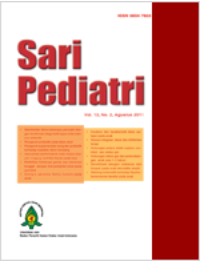Infeksi Bakteri Gram Negatif di ICU Anak: epidemiologi, manajemen antibiotik dan pencegahan
Sari
Rumah sakit dan unit perawatan intensif (ICU) merupakan breeding ground atau tempat
berkembangnya bakteri yang resisten/multiresisten antibiotik, disebabkan penggunaan
alat invasif, kontak yang sering antara staf rumah sakit dengan pasien sehingga
memudahkan terjadi transmisi infeksi, intensitas penggunaan antibiotik yang tinggi serta
penggunaan antibiotik empiris yang berlebihan. Hal tersebut terjadi karena pasien yang
dirawat di ICU pada umumnya menderita penyakit berat dan dalam kondisi
imunokompromais.1,2
Bakteri Gram negatif mempunyai tingkat resistensi tinggi karena mempunyai mekanisme
resistensi yang multipel. Mekanisme resistensi bakteri Gram negatif terhadap antibiotik
b laktam, terutama disebabkan karena bakteri Gram negatif menghasilkan enzim b
laktamase. Berdasarkan hal tersebut, dapat dipastikan bahwa infeksi oleh bakteri Gram
negatif merupakan ancaman, terutama pada pasien imunokompromais
Kata Kunci
Teks Lengkap:
PDFReferensi
Al-Lawati AM, Crouch ND, Elhag KM. Antibiotic consumption
and the development of resistance among
Gram-negative bacilli in intensive care units in Oman.
Annals of Saudi medicine 2000;20:325-7.
Lewis LL, Pizzo PA. Infections in the hospitalized and
immunoincompetent child. Dalam: Katz SL, Gershon
AA, Hotez PJ. Penyunting Krugman’s Infectious diseases
of children, 10thed. Philadelphia: Mosby,1998, p.213-35.
Waterer GW, Wunderink RG. Increasing threat of Gramnegative
bacteria. Crit Care Med 2001;29:N75-81.
Georgopapadakou NH. Antibiotic resistance in enterobacteria.
Dalam: Lewis K, Salyers AA, Taber HW, Wax
RG. Bacterial resistance to antimicrobials, 10thed. New
York: Marcel Dekker,2002, p.405-26.
Athale UH, Brown RC, Furman WL. Immunomodulation.
Dalam: Patrick CC. Penyunting Clinical Management of
Infections in Immunocompromised Infants and Children,
st ed. Philadelphia. Lippincott Williams & Wilkins, 2001,
p.584-615.
Abbas AK, Lichtman AH. Innate immunity. Dalam:
Abbas AK, Lichtman AH. Penyunting Cellular and
Molecular Immunology, 5thed. Philadelphia. Saunders,2003, p.275-97.
Long SS, Dowell SF. Anti-infective therapy. Dalam: Long
SS, Pickering LK, Prober CG. Penyunting Principles and
Practice of Pediatric Infectious Diseases, 2nded. Philadelphia:
Churchill Livingstone,2003, p.1422-32.
Toltzis P, Yamashita T, Vilt L, Blumer JL. Colonozation with
antibiotic-resistant Gram-negative organisms in a pediatric
intensive care unit. Crit Care Med 1997;25;538-44.
Niederman MS. Appropriate use of antimicrobial agents:
Challenges and strategies for improvement. Crit Care
Med 2003;31(2):608-16.
Garcia-Rodriguez JA, Jones RN. Antimicrobial resistance
in Gram-negative isolates from European Intensive Care
Units: data from the Meropenem Yearly Susceptibility
Test Information Collection (MYSTIC) Programme. J
Chemotherapy 2002;14):25-32.
Itzhak L, Leonard L, Moshe D, Zmira S, Hana K, Shai
A. A prospective study of Gram negative bacteremia in
children. Pediatr Infect Dis J 1996;15:117-22.
Bush K. Beta-lactamases and ESBL. Dikutip dari
tayangan presentasi pada 4th International Symposium
on Antimicrobial Agents and Resistance (ISAAR) 2003,
Seoul-Korea, 16-18 Juli, 2003.
Garau J. b-lactamase-mediated resistance in nosocomial
respiratory tract infections. Dalam: Akalin HE. Penyunting
Proceedings from the 3rd Net Care Meeting: Respiratory
Tract Infections. Phuket-Thailand. 2001, p.37-45.
Eggimann P, Pittet D. Infection control in the ICU: critical
care reviews. Chest 2001;120(6):2059-93.
Mayer KH, Opal SM, Medeiros AA. Mechanisms of
antibiotic resistance. Dalam: Mandell GL, Douglas RG,
Bennett JE. Penyunting Principles and Practice of Infectious
Diseases, 4thed. New York: Churchill
Livingstone,1995, p.218-28.
Carlet J. Antibiotic management of severe infections in
critically ill patients. Dalam: Dhainaut J-F,. Penyunting
Thijs LG, Park G. Septic Shock, 1st ed. London. WB
Saunders, 2000, p.445-60.
Goldmann DA, Weinstein RA, Wenzel RP, et al. Consensus
statement: strategies to prevent and control the
emergence and spread of antimicrobial-resistant microorganisms
in hospitals, a challenge to hospital leadership.
JAMA 1996;275:234-40.
Rahal JJ, Urban C, Horn D, et al. Class restriction of
cephalosporin use to control total cephalosporin resistance
in nosocomial Klebsiella. JAMA 1998; 280:1233-7.
Burke JP. Rational antibiotic use to combat the emergence
of resistance. Dalam: Akalin HE. Penyunting Proceedings
from the 3rd Net Care Meeting: Respiratory
Tract Infections. Phuket-Thailand. 2001, p.58-66.
Kollef MH, Vlasnik J, Sharpless L, Pasque C, Murphy
D, Fraser V. Scheduled change of antibiotic classes: a strategy
to decrease the incidence of ventilator-associated pneumonia.
Am J Respir Crit Care Med 1997;156:1040-8.
Shlaes DM, Gerdin DN, John JF Jr, et al. Society for
Healthcare Epidemiology of America and Infectious
Diseases Society of America Joint Committee on the
Prevention of Antimicrobial Resistance: Guidelines for
the prevention of antimicrobial resistance in hospitals.
Clin Infect Dis 1997;25:484-99.
Moss WJ, Beers MC, Johnson E, et al. Pilot study of
antibiotic cycling in a PICU. Crit Care Med
;30:1877-82.
Toltzis P, Dul MJ, Hoyen C, et al. The effect of antibiotic
rotation on colonization with antibiotic-resistant
bacilli in a neonatal intensive care unit. Pediatrics
;110:707-11.
Gruson D, Hilbert G, Vargas F, et al. Rotation and restricted
use of antibiotics in a MICU: impact on the
incidence of ventilator-associated pneumonia caused by
antibiotic-resistant Gram-negative bacteria. Am J Respir
Crit Care Med 2000;162:837-43.
Cunha BA. Antibiotic resistance. Medical Clinics of
North America 2000;84: 1407-29.
DOI: http://dx.doi.org/10.14238/sp6.1.2004.32-5
Refbacks
- Saat ini tidak ada refbacks.
##submission.copyrightStatement##
##submission.license.cc.by-nc-sa4.footer##
Email: editorial [at] saripediatri.org


Sari Pediatri diterbitkan oleh Badan Penerbit Ikatan Dokter Anak Indonesia
Ciptaan disebarluaskan di bawah Lisensi Creative Commons Atribusi-NonKomersial-BerbagiSerupa 4.0 Internasional.





